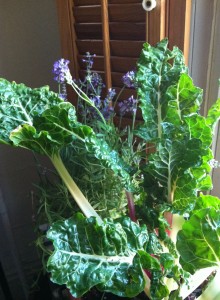All is going well until the blowtorch of July’s heat wave strikes. Worst affected is my Swiss chard, which I’m sure would be much happier in Alpine splendor than it is in the scorching New Jersey sun. The leaves used to be crisp atop sturdy red, yellow, and white stalks. But when I come home from work on that first blistering day, I find both leaves and stalks drooping limply over the side of the terracotta planter. They remind me of a jilted 19th century heroine, lying prostrate on the swooning couch. I imagine their reproach: “How could you abandon us all day without fresh water?” The lavender is listless, too, and the butterfly bush rapidly wilting.
I have been giving my garden roughly 2 gallons of water a day until this point. Suddenly that amount escalates to 5 and even 7 gallons. I’ve read that containers dry out much faster than normal ground, since they’re more exposed to the heat. But I’m shocked at how often I have to water these plants now and how much liquid they soak up each time, swallowing the contents of entire 2.5-gallon watering cans at a gulp.
 In the end, there is no recourse but to bring the chard, cherry tomatoes, and lavender inside and give them respite in our air conditioned living room. (That’s at least one advantage over an in-ground garden. You can’t uproot the pumpkin patch and carry it all inside.) Overnight, my plants revive. But how long will I have to leave them indoors, with the mercury soaring?
In the end, there is no recourse but to bring the chard, cherry tomatoes, and lavender inside and give them respite in our air conditioned living room. (That’s at least one advantage over an in-ground garden. You can’t uproot the pumpkin patch and carry it all inside.) Overnight, my plants revive. But how long will I have to leave them indoors, with the mercury soaring?
I keep an anxious eye on the other plants that are still outside. Some are actually living up to their “heat-tolerant” billing. The purslane—that semi-succulent Mediterranean specimen—seems to be thriving. And the mandevilla, a tropical beauty, is handling the situation just fine. Most remarkably, the petunias look as fresh as the day I bought them.
Still, I can’t wait for this heat wave to pass.

